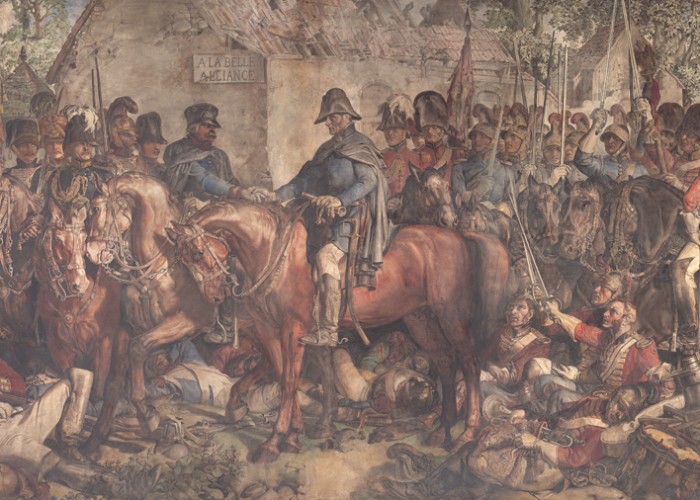The Meeting of Wellington and Blücher at Waterloo
This enormous mural, painted by the artist Daniel Maclise, shows the meeting of the victorious British and Prussian Generals at the end of the Battle. It is painted on the walls of the Royal Gallery in the House of Lords, Westminster.
Click here to see a full, larger-sized version of the mural.
The Waterloo mural was completed in 1861, with its Trafalgar companion following four years later. The artist in both cases was Daniel Maclise (1806-1870). Now little-known, Maclise used an experimental technique known as water-glass painting. It was hoped that this would prevent the image from degrading in the polluted London air, but this hope was not realised, and both murals are now badly faded.
The choice of scene is an interesting one, for rather than showing some heroic tableau from the action at Waterloo, it depicts instead the final stages of the battle and the meeting between Wellington and his Prussian ally, Generalfeldmarschall Gebhard Leberecht von Blücher. The location is near the aptly-named Belle Alliance inn, which underlines the fact that this is a depiction not of a British but of an allied success. The two commanders are flanked by troops from their respective armies; men of the Household Brigade behind Wellington, and a retinue of staff officers and hussars behind Blücher. In the background, more allied cavalry complete the rout of the French. As well as fallen Frenchmen, the dead and wounded include Prussian as well as British casualties, emphasising the 7,000 men lost by Blücher’s army during their bitter struggle on the battle’s eastern flank.
The emphasis on an allied victory makes sense in the context of the day, with Britain’s strong ties to Germany on the one hand, and the existence of a resurgent Bonapartist France under Napoleon III on the other. Waterloo was seen as having established a unified and peaceful Europe, and it made sense for this to be depicted in the Royal Gallery, where, amongst other important state events, foreign monarchs and statesmen could address Parliament. Only in later years, when French politicians have spoken in the gallery, has a less tactful note been struck. This, along with the severe fading, has led to recent calls for the murals to be replaced.
-
Curatorial info
- Originating Museum: House of Lords, Palace of Westminster
- Accession Number: WOA 3246
- Production Date: 1861
- Creator: Daniel Maclise
- Material: Waterglass painting
- Creation Place: London
- Technique: Waterglass
- Size: Height 368.3cm x Width 1392cm
-
Use this image
You can download and use the high resolution image for use in a non-profit environment such as a school or college, but please take note of the license type and rights holder information below
- Rights Holder: Parliamentary Copyright
- License Type: All Rights Reserved
Find it here
This object is in the collection of Houses of Parliament







